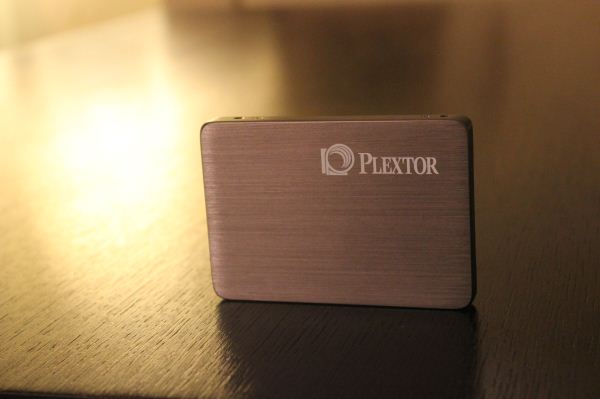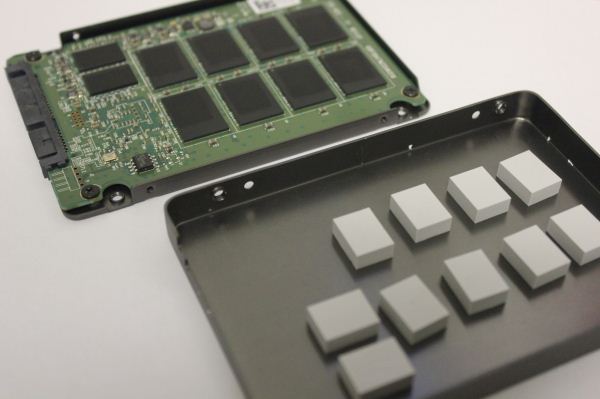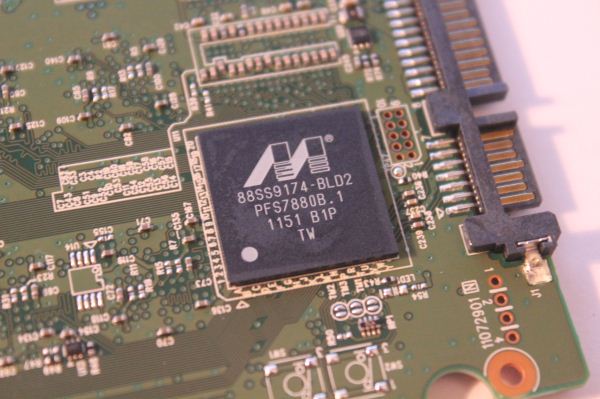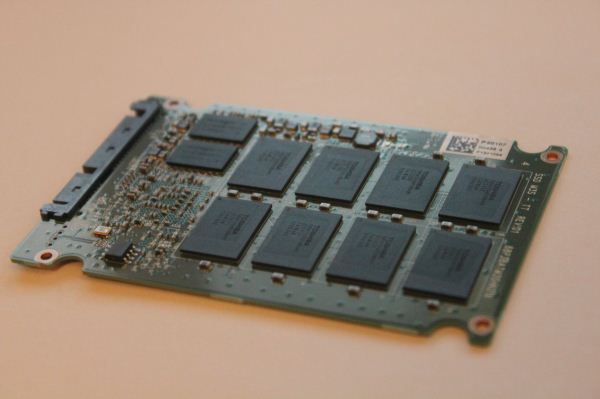The Plextor M3 (256GB) Review
by Kristian Vättö on April 5, 2012 3:05 AM ESTThe Plextor M3
Plextor sent us a 256GB model of their M3 series. Below is a table containing the specifications of their M3 line.
| Plextor M3 Specifications | ||||
| Model | PX-64M3 | PX-128M3 | PX-256M3 | PX-512M3 |
| Raw NAND Capacity | 64GiB | 128GiB | 256GiB | 512GiB |
| Formatted Capacity | 59.6GiB | 119.2GiB | 238.5GiB | 476.9GiB |
| Number of NAND Packages | 8 | 8 | 8 | 8 |
| Number of die per Package | 1 | 2 | 4 | 8 |
| Sequential Read | 520MB/s | 510MB/s | 510MB/s | 525MB/s |
| Sequential Write | 175MB/s | 210MB/s | 360MB/s | 445MB/s |
| 4K Random Read | 55K IOPS | 70K IOPS | 70K IOPS | 56K IOPS |
| 4K Random Write | 40K IOPS | 50K IOPS | 65K IOPS | 30K IOPS |
| Cache (DDR3) | 128MB | 256MB | 512MB | 512MB |
The Plextor M3 is available in all the standard capacities. In the light of the performance specifications, the M3 looks very promising. It beats its closest match, the Crucial m4, in all aspects. It's very competitive even with SandForce based SSDs and especially the stated random read figures are great.
| NewEgg Price Comparison (4/2/2012) | ||||
| 64GB | 128GB | 256GB | 512GB | |
| Plextor M3 | $110 | $180 | $340 | $660 |
| Crucial m4 | $88 | $155 | $315 | $630 |
| Intel 520 Series | $110 | $180 | $345 | $800 |
| Samsung 830 Series | $105 | $185 | $300 | $780 |
| OCZ Vertex 3 | $90 | $178 | $340 | $770 |
Price wise the M3 is not the cheapest SSD, especially in the smaller capacities. There is about $10-15 premium in the 64GB and 128GB models but 256GB and 512GB models are more competitively priced. Crucial's m4, however, comes in as a cheaper option than the M3 at every capacity so that will be a key matchup where Plextor has to win on performance or come down in pricing.
The external design of Plextor M3 is very solid. When I first saw it, it reminded me of Samsung 830 with its brushed metal finish. Only the Plextor logo has been printed on the front—The model and other important information are printed on a sticker on the back of the drive. The drive package includes a 3.5" bracket, quick installation guide, and a software CD, which includes a clone&backup utility along with performance analyzer. Plextor is giving the M3 a top notch 5-year warranty as well.
Each of the main components (controller, NAND devices, and DRAM) have their own little thermal pad. Since the chassis is also made out of metal, heat dissipation should not be a problem.
Inside we find Marvell’s 88SS9174-BLD2 controller (or just 9174). This is the same controller that's in Crucial's m4, but the firmware is custom developed by Plextor. It’s actually a bit surprising, yet very refreshing, to see a Marvell based SSD for a change. Everyone seems to have a SandForce solution these days. We have seen that Marvell can be competitive; you just need to take the time to customize the firmware to get good performance. The stock SandForce firmware is fast enough, so it's obvious that many companies choose to go with the easiest option.
Flip the PCB and we find eight Toshiba 24nm 2-bit-per-cell MLC NAND devices. That’s coupled with two 256MB DDR-1333 chips from Nanya, giving a total of 512MB of DDR3 cache.
Toshiba uses a Toggle-Mode interface and the current iteration (2.0) of Toggle-Mode NAND is good for up to 400MT/s per interface. Rating speed by transfers is a bit annoying as it doesn't tell us the actual bandwidth—for that we need the width of the channel and transfers per second. The channel in this case is 8 bits wide, so that works out to be 3.2Gbps per interface, or 400MB/s. With eight NAND packages, the maximum throughput works out to be 3200MB/s, over four times more than what SATA 6Gb/s can provide. Of course, reading from NAND and dumping the data into a register is one thing; it's another matter to actually transfer the data to a host controller over the interface.
We want to provide a quick word about firmware updates before we go into benchmarks. The drive came with FW 1.01, which was the latest at that time. Plextor has recently released FW 1.02 which is supposed to fix some issues but all our tests have been done using FW 1.01. Plextor is not claiming increased performance in the release notes of the update. The actual process of updating the firmware is very simple. Download a small ISO (~3MB) from Plextor's site, burn that to a CD or USB stick and boot from that. Press Enter and it automatically flashes the drive. I even had all my other drives plugged in and there was no problem.
The Test
| CPU |
Intel Core i5-2500K running at 3.3GHz (Turbo and EIST enabled) |
| Motherboard |
AsRock Z68 Pro3 |
| Chipset |
Intel Z68 |
| Chipset Drivers |
Intel 9.1.1.1015 + Intel RST 10.2 |
| Memory | G.Skill RipjawsX DDR3-1600 2 x 4GB (9-9-9-24) |
| Video Card |
XFX AMD Radeon HD 6850 XXX (800MHz core clock; 4.2GHz GDDR5 effective) |
| Video Drivers | AMD Catalyst 10.1 |
| Desktop Resolution | 1920 x 1080 |
| OS | Windows 7 x64 |
Our regular readers may notice that my testbed is not exactly the same as Anand's. Anand's setup is based on Intel's motherboard with H67 chipset, whereas mine is an ASRock board based on Intel's Z68 chipset. The important bit here is that both feature native SATA 6Gb/s support and both setups use the same drivers. Other features and components don't really have an effect on SSD testing. For example the average CPU usage during write speed tests is less than 5%.














113 Comments
View All Comments
magnetar - Saturday, April 7, 2012 - link
... that the Intel 510 SSD also uses the Marvell 9174 controller. I'm pleased that the 510 is still included in many SSD reviews at AnandTech, although it is dismissed as old and slow by some enthusiasts.The Samsung SSD Magician is the "gold standard" of SSD support programs? Personally I prefer Intel's SSD Toobox, the 3.0 version of course. I use both, and they are excellent, I've never had a problem with either of them. I like Intel's Toolbox UI over Samsung's Magician, the latter running in the background when not in use for some reason. Magician has more functions than the Toolbox, so has it beat in that aspect. Both allow firmware updates in the Windows environment... priceless!
LokutusofBorg - Saturday, April 7, 2012 - link
Yeah, I noticed this too. That part of the article should be updated to say "Intel's 510 and 520 series..." or some such.sunsin - Saturday, April 7, 2012 - link
Kristian, I compared the result with Intel SSD 520Intel SSD 520 240GB Clean 284.5 MB/s After Torture 162.9 MB/s After TRIM 162.9 MB/s
Plextor M3 256GB Clearn 328 MB/s After Torture 302.1 MB/s After TRIM: 327.1 MB/s
The Plextor M3 has way better performance than Sandforce based SSD where the TRIM will never restore the clean performance. This does mean that Plextor will be better option for long term use.
In addition, you mentioned that Sandorce based SSD will be a better choice for OS without official TRIM support, please provide some comparative figure to support this. The After Torture performance for Plextor vs Sandforce can be 302.1 vs 162.9 MBs. The win by 80%. Please explain why you always suggest Sandforce based SSD For OS without TRIM?
Kristian Vättö - Saturday, April 7, 2012 - link
First off, we use different methods for TRIM testing on SF and non-SF drives. Non-SF drives are filled and tortured with compressible data as that is what HD Tach uses. SF drives, on the other hand, are filled and tortured with incompressible data and then benchmarked with AS-SSD which uses incompressible data as well. The length of the torture can vary as well. Hence you can't directly compare the results.In the case of Intel 520 and Plextor M3, Intel 520 was tortured for 60 minutes and it still managed a speed of 162.9MB/s. The numbers you have for Plextor are after 20 min torture. I also included a graph of 60min torture and the average write speed dropped to 54.9MB/s. Does this make sense to you now?
SandForce's advantage is extremely low write amplification: http://images.anandtech.com/graphs/graph5529/44082...
When you write less, there is also less garbage collection to do. Here is one graph that Anand linked earlier which compares TRIM/GC of drives: http://images.anandtech.com/graphs/graph5719/45462...
However, like I noted in the TRIM part, there should be absolutely no problem in running M3 in an OS without TRIM. IF you are an extreme user and you'll be constantly hammering the drive under OS with no official TRIM support, then a SandForce drive may be a better solution. Most people's workload isn't like that and any decent SSD should do the job.
I maintain a huge SSD sticky at MacRumors and I've only seen a few users complain about performance degradation, and nowadays we would consider those SSDs to be ancient anyway. Besides, if the performance degrades, you can always enable TRIM temporarily in OS X and TRIM the drive, then disable TRIM.
jwilliams4200 - Monday, April 9, 2012 - link
Note that the "Steady State 4KB Random Write Performance" graph has highly misleading results.The steady-state 4KB QD=32 random write performance of the Vertex 3 when tested with random data streams (as the industry-standard SNIA protocol specifies) is only about 30MB/s, not 159MB/s as anandtech.com's graph incorrectly shows. You can see the correct results in either of these reviews:
http://www.xbitlabs.com/articles/storage/display/m...
http://www.storagereview.com/plextor_pxm3p_ssd_rev...
It is disappointing for anandtech.com to get a simple test like this so very wrong.
kissfan003 - Saturday, April 7, 2012 - link
Plextor an unknown... Dang, I'm old... They were the best optical drive "back in my day"...ejiggyb - Sunday, April 8, 2012 - link
Plextor used to be the only one for me, way back when Adaptec software was the king. That became Roxio. I had 3 different models they all became junk after a little use. They would automatically change speed if i was ripping a CD down to 2 speed unless I held the open button for a few seconds before I put in the CD. I spent a pretty penny for all them. To bad, I was a huge fan.yyrkoon - Sunday, April 8, 2012 - link
"As far as brand awareness for Plextor, I believe the reason for their relative obscurity of late has been the lack of media awareness and contacts. Their journey to become an SSD manufacturer has been rather abnormal. When you think of the history of other SSD manufacturers, they were mostly known for RAM before entering the SSD world."While I wont argue that Plextor is/is not in the RAM business. Since when in the context of this article has Plextor been known for it's RAM products ? The general audience here being computer enthusiasts, and not Electronic Engineers. Even then, being in embedded design myself ( as a very serious hobby ) I can not say with all honesty that I have even heard of a Plextor memory chip/stick.
I think most/all power users that have been around over the last 10+ years would agree that Plextor is most noted for it's optical drives. Specifically the bit for bit copy models. Like another reader, I own a UW SCSI UltraPlex myself, and it is still going strong to this day. Though admittedly, it has not been very useful for years.
Kristian Vättö - Sunday, April 8, 2012 - link
I was specifically talking about other SSD manufacturers. Think e.g. OCZ and Crucial, both are RAM manufacturers. Plextor's journey is abnormal because they never made RAM or other components, only ODDs. I was not claiming that Plextor is a RAM manufacturer.yyrkoon - Sunday, April 8, 2012 - link
Ah ha. I see now. *Other* SSD manufactures . . My mistake.. Sorry.So looking at things from that perspective.
Plextor started off as the go to brand for many people where optical drives were concerned. Their CD writers / readers were second to none.. Often far exceeding the competition in performance, and features.
Now days, like anyone else. It seems Plextor is only interested in making throw-away ( reference design ) products. No more pride in the brand.
Going by the information given to us in your review, it seems perhaps Plextor is trying to put effort into at least this product, With great results ( so it seems ). Perhaps even trying to regain their good name of the past,
With the above said, I think I would have to give Plextor a pass. Simply because their recent track record says one thing to me( by recent i mean the last several years ). *Money*. Not the end user, not even their good reputation. That goes back to your comments about the cost as well.
Happily, I would love to be proven wrong. However, I would not hold my breathe passed 6 months where software support is concerned.
Thank you for your non condescending response Though, I probably deserved it heh.